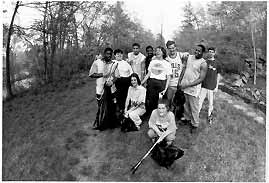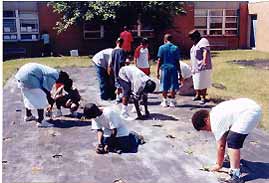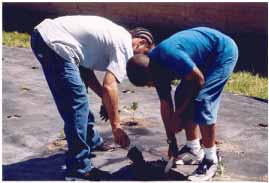February 2004 // Volume 42 // Number 1 // Research in Brief // 1RIB4
Identifying What 4-H'ers Learn from Community Service Learning Projects
Abstract
The article reports a study determining what 4-H delegates learned from community
service learning projects conducted at Virginia's 4-H Congress. Four hundred
and fifteen 4-H delegates participated and completed open-ended reflection
instruments to address the research question. Delegates indicated they learned:
(a) the importance of helping youth and the community, (b) new skills and information,
(c) the significance of teamwork, (d) project ideas, and (e) resources to assist
with project implementation. Additionally, their feedback helped identify project
experiences that were ineffective. This information will ultimately assist
program developers to successfully integrate community service learning programming
into Virginia's 4-H curriculum.
Introduction
There is an ancient Chinese proverb that states, "Tell me, and I will forget. Show me, and I will remember. Involve me, and I will understand" (Seigel & Rockwood, 1993, p. 67). Community service has always been an important part of 4-H youth development; however, throughout the past 25 years, the community service emphasis has changed. While community service provides positive short-term and immediate impact on youth, it requires little training and explanation (Freeman, 2000) and may thus fall short of developing a true connection to learning.
Four-H therefore challenges leaders and volunteers to take community service to a higher level. To do so it is necessary to conduct community service in a manner that reflects educational growth and development. Community service learning provides a mechanism to do just that.
Community service learning is defined as "a form of experiential learning in which youth apply the subject matter they are learning, along with critical thinking skills, to address genuine community needs (Smith, 1997, p. 3)." It consists of three components that give it educational integrity:
- Combining community service with thoughtful reflection,
- Connecting the project to a formal curriculum, and
- Helping students develop skills and attitudes that lead to civic engagement and caring (Freeman, 2000; National and Community Service Act of 1990, 1991; Smith, 1997; & Youth Service America, 2002).
Virginia's 4-H programs include a statewide goal to develop successful models for community service learning and to contribute to the educational development of youth through meaningful service learning activities. This article presents an assessment of what 4-H youth learned from their involvement in community service learning projects at 4-H Congress. This information can ultimately assist youth specialists in successfully integrating community service learning programming into Virginia's 4-H curriculum.
Program Description
Community service learning projects were conducted at Virginia's annual 4-H Congress to provide meaningful service learning experiences for 4-H youth. Approximately 425 youth (4-H delegates) between the ages of 14 and 17 participated in the projects. Delegates made selections from among 24 different community service learning projects. Projects were held over the course of 2 days.
The projects were designed to follow the steps of the Community Service Learning Cycle. The cycle is based upon the experiential learning model, which emphasizes learning by doing, and includes the following five steps:
- Assess needs,
- Plan and prepare,
- Experience meaningful service,
- Analyze and generalize, and
- New application.
The cycle is designed so that after its use, individuals develop skills, knowledge, and experiences that prepare them to begin another more challenging project (Smith, 1997). Reflection, although not listed as one of the five steps, is one of the most important aspects of the model and should be interwoven during the project planning process, during project involvement, and after the project is complete.
Methods
Four-H delegates participated in service learning activities that tie directly to the 4-H curriculum. This component is essential to providing a successful community service learning experience. The project topics, project activities, and 4-H curriculum areas involved in this project are listed in Table 1.
|
Project topics |
4-H Curriculum Areas Addressed Through Project Activities |
Project Activities Conducted Within the 4-H Curriculum Areas |
|---|---|---|
|
Historical Park Maintenance and Beautification Projects |
|
|
|
Fire and Rescue Experience Projects |
|
|
|
Volunteer Clothing Shop Assistance Projects |
|
|
|
Service Learning Simulations |
|
|
Ideally, 4-H delegates should be involved in all steps of the community service learning cycle when conducting community service learning projects. Because the projects were identified during the conference-planning phase, delegates were unable to conduct steps one and two of the community service learning cycle. Instead, the 4-H Specialist who organized the project conducted these steps. Distance and time constraints made it difficult to include 4-H delegates in these steps. Delegates were, however, given an opportunity to participate in the community service learning project of their choice.
To prepare for the projects, the state 4-H Specialist solicited participation from service organizations within communities surrounding the conference site. The specialist then identified a project leader from within each organization to:
- Guide the project,
- Discuss the nature and goals of the project,
- Explain the responsibilities of the project leader,
- Establish a time frame, and
- Conduct phone interviews to determine whether or not the organization could provide a valuable community service learning experience.
Four-H agents assisted project leaders in supervising each project and conducted service learning reflection with delegates.
Figure 1.
Teens Working on a Beautification Project Along the Appomattox River

Figure 2.
4-H Youth Working on a Garden Project at a Local Elementary School

Figure 3.
4-H Teen Mentoring Youth at the Garden Project

A written reflection instrument was developed to elicit responses to open-ended reflection questions indicating what delegates learned, as well as how they thought, felt, and processed their experiences during the project. Questions from the written instrument were taken from the community service learning publications of Smith (1997) and Decker and Moffat (2000). The instrument was pilot tested by 12 4-H agents who reviewed it for clarity and content. Reflection questions include the following:
- Did you listen and include everyone's ideas when planning how the work would be done?
- How does this project relate to projects you have done before?,
- What are you learning from the experience?,
- How do you feel as a result of the experience?,
- What do you think others learned from the project?,
- What did you learn?,
- What were the successes of the project?, and
- What could you have done better?
Under the leadership of a project leader, delegates met at the 24 different project sites, organized responsibilities and workloads, and completed the work experience. The 4-H agent in charge of each project then conducted reflection with the delegates during and after project completion. While the delegates were involved in project activities, 4-H agents discussed sections from the written reflection instrument. Agents asked delegates to address questions from the instrument as they worked. The questions required delegates to think about how and why they made specific decisions about the job they were performing. At the projects' culmination, delegates completed the written reflection instrument.
Written responses obtained from the reflection instrument were transcribed, and content analysis was conducted using Provalis Research Simstat software. This software facilitated the analysis of written reflection responses and allowed the researcher to attach codes to data and then locate data that was commonly coded. The transcribed data were fractured and reassembled using different combinations. As words and expressions were analyzed, they were continuously compared to and against other words and expressions. This process allowed the researcher to determine the meaning of data and develop data new categories. Ultimately, it allowed the researcher to confidently identify the six themes presented in the results.
Results
Based upon data obtained from written reflection responses (See Table 2 for data display), delegates expressed what they learned from their involvement in community service learning projects at 4-H Congress through the following themes:
- The importance of helping youth and the community
- New skills and information
- The significance of teamwork
- Project ideas
- Resources to assist with project implementation
- Ineffective experiences
|
Theme Title |
Theme Description |
Reflection Responses |
|---|---|---|
|
1. The importance of helping youth and the community |
Section I: |
Section I:
|
|
Section II: |
Section II:
|
|
|
2. New skills and information |
Section I: |
Section I:
|
|
Section II: |
Specific skills mentioned:
Other delegates mentioned specific techniques learned, such as first aid, or methods for keeping wild animals away from gardens. |
|
|
3. The significance of teamwork |
Delegates noted the triumph of working in teams and how doing so allowed them to accomplish tasks that would have been difficult to accomplish alone. Approximately 27% of respondents remarked that they would have been unable to accomplish tasks without utilizing a team effort. |
|
|
4. Project ideas |
Twenty-three percent of delegates indicated that the project generated ideas to take to their own communities, although they did not identify specific ideas. They also recognized a newly discovered ability to use these ideas to educate members within the community and within their own 4-H clubs. |
|
|
5. Resources to assist with project implementation |
Delegates recognized the importance of obtaining community assistance when conducting community service learning projects. Specific individuals were mentioned as necessary to create effective community projects and were identified as having resources to contribute to local projects. |
|
|
6. Ineffective experiences |
17% of delegates indicated that they did not learn anything from the projects. Those who participated in service learning simulations more often cited them as being less beneficial than those who participated in other projects. Overall, participants viewed these projects as cheap labor that provided less of a connection to what they felt was the purpose of service learning. |
Reasons cited for not learning anything from project involvement:
|
Conclusions and Recommendations
The results of this project identified what delegates learned from participating in community service learning projects at 4-H Congress and provide implications to enrich future projects. Delegates indicated that the projects evoked a strong sense of altruism, taught them new skills or information about a topic to which they had little prior knowledge or exposure, taught the importance of teamwork, and assisted them in generating ideas and resources for future projects.
These findings support the notion that doing something useful for society evokes a feeling of belonging and contributing that sustains individuals even when the work is difficult. Also, service learning provides students with opportunities to use newly acquired skills and knowledge in real-life situations in their own communities (Howe, 1986; Wade, 2002). Overwhelmingly, delegates cited the projects as being valuable and beneficial to their development in 4-H.
Because 17% of delegates indicated that they did not learn anything, the 4-H Specialist concluded that there is room for improving the projects at 4-H Congress as well as opportunities to create more beneficial service learning experiences. Delegates viewed the projects as valuable learning experiences; however, whether the projects moved them to conduct similar projects within their individual clubs and communities is questionable. Follow-up is necessary. Nonetheless, this information is valuable in determining what is needed to improve future community service learning experiences at 4-H Congress.
The community service learning projects at 4-H Congress lacked a commitment process to encourage delegates to conduct projects within their home communities. After project completion, time was needed for delegates to meet with agents, volunteers, and fellow delegates to develop future project ideas.
Establishing a written commitment would have allowed the 4-H Specialist in charge to follow-up with individual districts. This process may have increased the likelihood that the project idea would have been expedited once the 4-Hers returned home. To further increase opportunities for future projects, the 4-H Specialist could assist agents and volunteers in selecting and conducting projects suitable for 4-Hers to conduct within their home communities.
Based on the information obtained from the study, the following recommendations should be considered when conducting community service learning projects.
-
Identify community service learning projects whose outcome will be valuable to members of the local community. That value should be clearly articulated with project participants.
-
Conduct projects that are well organized and provide rich experiences for participants.
-
Conduct projects involving activities that can be directly tied to the 4-H curriculum.
-
Include project participants in all steps of the community service learning cycle when conducting projects...particularly during planning phases.
-
Make a direct connection to identify how statewide projects, such as those conducted at 4-H Congress, can be tied to projects conducted within individual communities.
-
Develop a process at 4-H Congress to create a commitment among 4-Hers to conduct projects within their individual communities once they return home. A project commitment sheet or a solid idea identified by a 4-H club or region, for example, would help expedite that process.
-
Conduct formal follow-up to determine whether or not projects are being conducted within individual communities.
-
Assist 4-H agents and local 4-H clubs in properly conducting community service learning projects within their communities.
References
Freeman, D. (2001). Service in 4-H: A concept paper. Report to the Virginia Leadership Council.
Howe, H. (1986, May). Can schools teach values? Remarks at Lehigh University, Bethleham, P.A.
National and Community Service Act of 1990. (1991). Definition of service-learning. In R. Willits-Caim & J. Kielsmeier (Eds.),. Growing hope. Minneapolis, MN: National Youth Leadership Council.
Seigel, S., & Rockwood, V. (1993, September 26). Democratic education, student empowerment, and community service: theory and practice. Equity and excellence in education. 65-70. EJ 476 935.
Smith, A. (1997). Beyond 4-H community service to community service learning. Cooperative State Research, Education and Extension Service. U. S. Department of Agriculture, Washington, D.C.
Wade, R. C. (2002). Community service learning: Collaborating with the community as a context for authentic learning. Contextual teaching and learning project papers and abstracts. Retrieved October, 2, 2002, http://www.bgsu.edu/organizations/ctl/navigation/constructs.html
Youth Service America. (2002). National Youth Service Day service learning curriculum. Youth Service America, Inc., Washington, DC.
